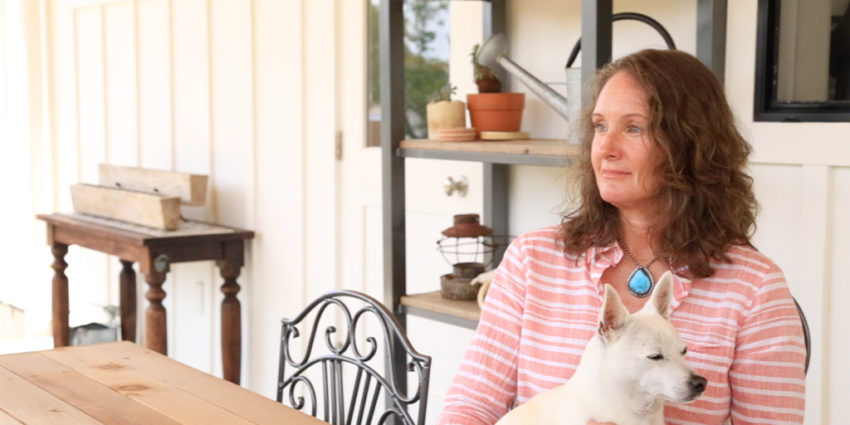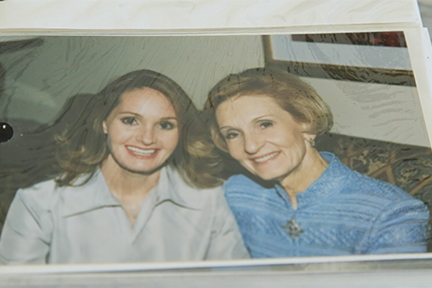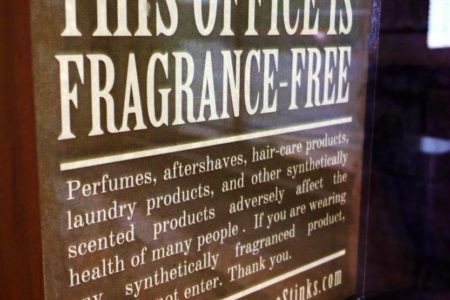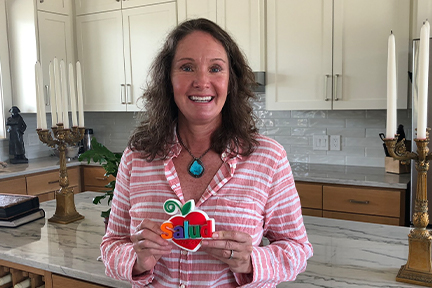
Share On Social!
For over 100 days in 1996, Melanie Cambron experienced migraines so severe she couldn’t leave her home.
Other maladies surfaced during this time — all of which had no reasonable explanation.
It wasn’t until she discovered she was one of the many people experiencing Toxicant-Induced Loss of Tolerance (TILT), that everything changed.
“My symptoms kept escalating,” Cambron said. “There was a lot of cognitive dysfunction, also known as brain fog—an inability to think and form rational thoughts—lots of depression, lots of anxiety, wild mood swings, and just general malaise.
“Doing one little activity, that would seem normal, would wipe me out for two days. I would be bedridden for a couple of days for just running one little, quick errand.”
Since this breakthrough, she reduced her exposure to harmful chemicals in all aspects of her life.
Moreover, Cambron started an online platform that helps inform people of the dangers of harmful chemicals found in products, cleaners, and other everyday items.
Early Signs and Lifelong Struggles with Chemical Sensitivity
While the height of her sickness began 20 years ago, chemical intolerance has been a problem for her for longer than she can remember.
In infancy, her skin began showing signs of rashes. Cambron’s mother, a user of name-brand laundry detergent, couldn’t find a cause for this concern.
“I had rashes all over me,” she said. “So, at the time, my pediatrician recommended ivory flakes [instead of detergent]. That was as close as the doctor could recommend to something that would be tolerable for me.”
With the switch came a decline in the rashes. Her mother, however, did not make a connection between chemicals in the detergent and her daughter’s side effects at the time.
Growing up, Cambron said she was a user of numerous items containing chemicals—from hairspray to nail polish—and experienced no notable, harsh reactions. 
It wasn’t until 1996 that everything came to a halt.
“For 100-plus days I had a migraine,” she said. “I had to either decapitate myself to make it stop, or I had to find somebody to help me.”
Experts at the Hoffman TILT Program at UT Health San Antonio, describe this process as initiation and triggering.
As chemically-sensitive individuals face toxic exposure from numerous sources—including fragranced products, furniture, water, and many others—a loss of tolerance to these substances develops. They said patients call this being “TILT-ed.”
One major low- or high-level exposure event can cause the initiation of TILT. Then, following low- or high-level exposures can result in recurring, worsening side effects, including:
- Difficulties with attention, memory, and mood
- Flu-like symptoms
- Gastrointestinal problems
- Allergy-like symptoms
- Migraines and headaches
- Fatigue and muscle pain
This illness is impacting millions worldwide, according to Dr. Claudia Miller, an environmental health professor and leader of the Hoffman TILT program at UT Health San Antonio.
“TILT can happen to anyone with sufficient exposure, and result in lifelong, disabling illness,” writes Miller. “Diverse chemicals, pesticides, solvents, diesel exhaust, and myriad indoor air contaminants outgassing from new construction or remodeling materials can initiate TILT. Although some people and families are more susceptible, overall the numbers appear to have grown in industrialized nations.”
Discovering TILT and Getting Better
Not only did Cambron experience severe migraines due to chemical intolerance, but other “life” consequences also cropped up as well.
“It is absolutely isolating. When you can’t safely go into your job, can’t socialize with family or friends, can’t go to church, it’s infuriating,” she said.
“It feels like you’re shouting into the wind. Everyone around you is using products that harm you, and you feel like you’re not being heard, or that you are a burden, or you are a nuisance, and people end up not wanting to be around you.”
Her discovery of TILT was pure luck, according to Cambron.
During her sickness in 1996, a friend recommended that she visit an acupuncturist who was familiar with those suffering from these kinds of symptoms.
It was in these sessions that she first learned of the harmful effects chemicals like Volatile Organic Compounds (VOCs) can have, especially on those who are sensitive.
After becoming aware of these issues, Cambron began a journey to discover more information on the subject.
Then, she would begin to make significant changes in her life. She notes that there are hundreds of resources and experts, naming Hoffman TILT’s Dr. Miller and Dr. Anne Steinemann, who can provide a vast amount of information.
Since learning about TILT, and her belief that she suffers from the illness, Cambron has moved to a ranch in the hill country outside of San Antonio (64% Latino).
Her home and the entirety of its contents are now chemically-minimized.
While she still can’t go far from her home without a respirator, Cambron has built a life around clean living.
To clean, she uses a mixture of baking soda and vinegar. Her walls are painted with low-VOC paint. For air conditioning and smell-reduction, Cambron and her husband open the windows to let fresh air flow through the house.
She says there’s an alternative to just about every chemically-harmful product out there.
Sharing a Chemical-Reduced Life with Others
As she changed her own home environment, Cambron also decided to take her knowledge of this problem to the next step: inform others of this issue.
“If I just kept all of this to myself, and just got me better, what a waste of information,” she said. “If I have a chance to make other people aware and healthy, and make changes, I’m going to share that information.”
So Cambron started her online platform, Fragrance Stinks, to improve the lives of those who suffer from chemical intolerance.
The idea behind this project began even before Cambron thought of it. 
“When I was home [sick], my sister told me she purchased my URL five years earlier, just knowing I had a lot to say on this topic,” Cambron said. “With nothing else to occupy my time, I knew that this was the perfect opportunity to start educating people about all of these toxic chemicals in all of these products that we think are just making things smell prettier, but they’re actually causing a whole host of health problems.”
She spends countless hours curating and creating content that helps inform people of the harmful chemicals found in products and also raising awareness of TILT as a condition.
Her motivation? To help create a world where people who suffer from her illness can function as a member of society — unlike how it is today.
“People look at you as if there is something wrong with you or you are just fabricating something,” Cambron said. “Then you start [finding others] on social media, and you realize that you are not alone. There are millions of us around the world who have been made sick by this and are now trying to teach others.”
Advocating for the Health of People with Chemical Intolerance
Her goal to inform people of the dangers some chemicals can pose doesn’t only live online. She also works with people to make changes in their lives.
Kelly Peterson, a friend of Cambron, began reading her online platform to show support.
However, the information Peterson found would change her life.
At the time, Peterson’s two sons and the family dog were experiencing a host of symptoms, including respiratory problems in the children and seizures in the pet. Hoping to combat those problems, the family got rid of chemically-harmful products from their home.
Within months, the children’s and the dog’s symptoms began to subside and eventually fade, according to Cambron. She said it is one of her favorite stories to tell. 
“Tears,” Cambron said. “Absolute tears. What a life change. Her two boys and her dog to not be struggling with respiratory issues and epilepsy anymore.”
She also works with her local community and independent school district, advocating for chemically-reduced schools and public spaces. Cambron even uses her own money to purchase safe school supplies for teachers.
She intends to continue her work in raising awareness about toxic chemicals in products, hoping to have more opportunities to speak in public — as long as it is at an outdoor venue.
What gives her the hope to continue pushing forward?
Partnering with others to spread better health.
“This is global,” Cambron said. “There is unity. This is not specific to me, or Texas, or the States. This is an issue that’s affecting people all around the world. If there’s a way we can all help each other, and help amplify that message — all the better.
Editor’s Note: This article is part of a collaboration between Salud America! and the Hoffman Toxicant-Induced Loss of Tolerance (TILT) program at UT Health- San Antonio. To find out if you are TILTed due to exposure to everyday foods, chemicals, or drugs, take a self-assessment or learn more about TILT.
Explore More:
Chemical & Toxic ExposureBy The Numbers
1
Quick Survey
Can help you find out how chemically sensitive you are
This success story was produced by Salud America! with support from the Robert Wood Johnson Foundation.
The stories are intended for educational and informative purposes. References to specific policymakers, individuals, schools, policies, or companies have been included solely to advance these purposes and do not constitute an endorsement, sponsorship, or recommendation. Stories are based on and told by real community members and are the opinions and views of the individuals whose stories are told. Organization and activities described were not supported by Salud America! or the Robert Wood Johnson Foundation and do not necessarily represent the views of Salud America! or the Robert Wood Johnson Foundation.



